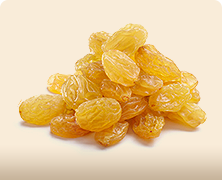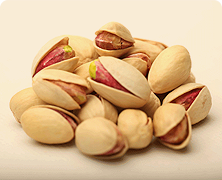İRAN ANTEPFISTIKLARINDA
The pistachio, a member of the cashew family, is a small tree originally from Central Asia and the Middle East. Pistachio trees can be found in regions of Iran, Syria, Lebanon, Turkey, Greece, Tunisia, Kyrgyzstan, Tajikistan, Turkmenistan, India, Pakistan, Egypt, Italy (Sicily), Uzbekistan, Afghanistan (especially in the provinces of Samangan and Badghis), and the United States, specifically in California. The tree produces a seed.
Arami Group supplying and exporting 3 kind of pistachios:
- Jumbo: Kalleh Ghouchi
- Long: Ahmad Aghai , Akbari
- Round: Fandoghi
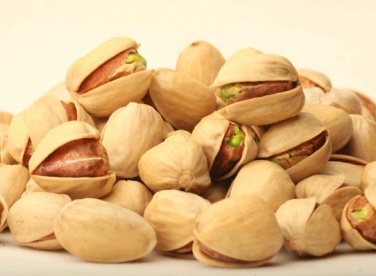
IRANIAN JUMBO PISTACHIOS
KALEH GHOUCHI (QOUCHI):
This nut is famous for being large. It is sensitive to shortage of water and its leaves are complex. This type of nut is vulnerable to cold weather in spring. It can be harvested in mid September.
On the whole Kalleh Ghouchi is not being budded anymore and production is from existing trees. Although commercially quite successful, Kalleh Ghouchi trees showed a steep drop in growth and production as they grew older than 40 years old. It is expected that the production would slowly decline.
Available sizes are 20/22, 22/24 and 24/26, with 18/20 being available in small quantities.
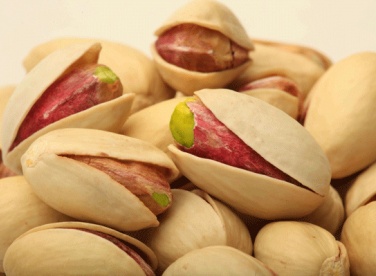
IRANIAN LONG PISTACHIOS
AKBARI:
This type is the highest economic value. Its fruits are large and almond shaped. It can be harvested in late September. This is a newer variety with good yield and with long, large nuts.
AHMAD AGHAEI:
This nut is rather large and its fruit is almond shaped. It can be harvested in late September. The newest commercial variety, very popular with the farmers, because of high yield and its shorter time to reach production. It is very popular in some markets like India and Greece. Production of this variety is increasing. It also has the whitest shell hue among the four.
Available sizes of Iranian Long Pistachio are 20/22, 22-24 and 24/26, with 18/20 also available in small quantities. Pistachio size unit is the number of nuts in one Once.

IRANIAN ROUND PISTACHIOS
FANDOGHI:
This cultivar is the most widely available pistachio variety and grows in most pistachio growing areas of Iran. Fandoghi is of round type and has the lowest shape index among the four cultivars. In recent years, around 50% of Iranian production is of the Fandoghi type. The reason is its limited yield, the new orchards are seldom planted with this variety.
It comes in the following sizes 28/30, 30/32 and 32/34 nuts per ounce. Size 26/28 is also available in small quantities.
diced pistachios
Iran and USA are the major producers of pistachios. There is no doubt that Iranian pistachio has the best taste and maximum nutrition. The special climate of Kerman province is the only best place for growing pistachios. Iran specialized in the production of pistachio kernels. USA practically did not supply any green kernels so far because of the high costs for the assortment needing a lot of manual labor. In order to obtain very green kernels, the pistachios are picked unripe − approx. a month before the normal harvest. At this time the pistachio kernel is very green and a little bit smaller. The riper a pistachio becomes, the bigger the kernel will be and the color changes from dark green to a light green/yellow. After harvest the shell must be mechanically cracked by a mill. Kernels with the violet skin coming out of the shells are swayed in hot water, so that the violet skin becomes loose. It is only loosened, but not yet taken off. The elimination of the skin is by means of vibration and suction. The pistachios run over vibrating steel slabs so that the loose skin comes off. As the skin is lighter than the kernels it can be sucked away. Another step of processing is the assortment by a laser scanner to get light and darker green colored kernels which are afterwards manually divided into 5 different color categories. In addition the percentage of broken kernels is a quality’s factor. The fewer broken kernels are in the merchandise, the higher the value.

Green Pistachio Kernel Superior quality
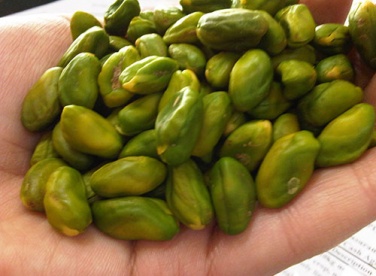
NUTRITION
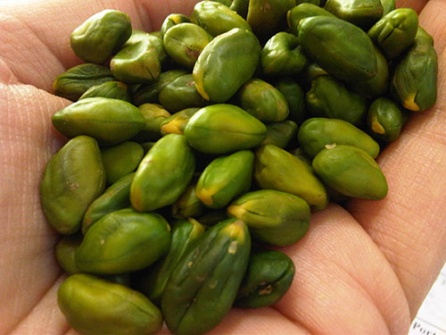
ИНФОРМАЦИЯ
HEALTH BENEFITS OF PISTACHIOS:
In research at Pennsylvania State University, pistachios in particular significantly reduced levels of low-density lipoprotein (LDL cholesterol) while increasing antioxidant levels in the serum of volunteers In rats, consumption of pistachios as 20% of daily caloric intake increased beneficial high-density lipoprotein (HDL cholesterol) without lowering LDL cholesterol, and while reducing LDL oxidation.
Consuming unsalted, dry-roasted pistachios prevents any addition of unwanted fats and additional sodium in the diet that may affect cardiac health adversely and increase hypertension.
Human studies have shown that 32–63 grams per day of pistachio seeds can significantly elevate plasma levels of lutein, alpha-carotene, beta-carotene, and gamma-tocopherol.
In December 2008, Dr. James Painter, a behavioral eating expert, professor and chair of School of Family and Consumer Sciences at Eastern Illinois University, described the Pistachio Principle. The Pistachio Principle describes methods of "fooling" one's body into eating less. One example used is that the act of shelling and eating pistachios one by one slows one's consumption, allowing one to feel full faster after having eaten less.
The fat profile of Pistachios is roughly 14% saturated fat, 54% monounsaturated fat and 32% polyunsaturated fat. A 1-cup serving of pistachio seeds contains 6.143g of saturated palmitic fatty acid, only 0.585g of stearic fatty acid and trace amounts of arachidic and behenic saturated fatty acids.


